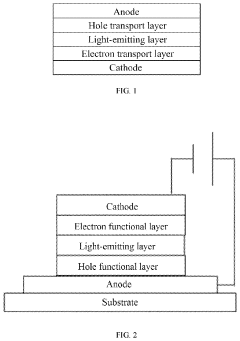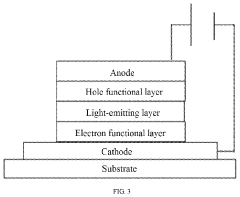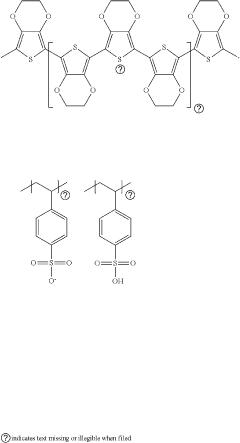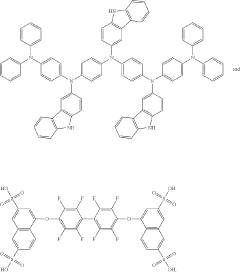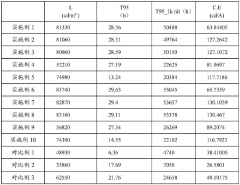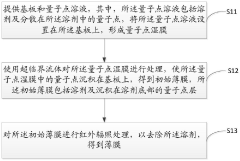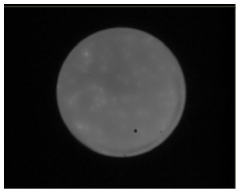How to Enhance Aesthetic Appeal through QLED?
JUN 20, 20258 MIN READ
Generate Your Research Report Instantly with AI Agent
Patsnap Eureka helps you evaluate technical feasibility & market potential.
QLED Aesthetics Evolution
The evolution of QLED (Quantum Dot Light-Emitting Diode) technology has significantly transformed the landscape of display aesthetics. Initially introduced as an enhancement to traditional LED-LCD displays, QLED has rapidly progressed to become a standalone technology, offering superior color reproduction and brightness levels that were previously unattainable.
In its early stages, QLED focused primarily on improving color accuracy and expanding the color gamut. This was achieved through the integration of quantum dots, nano-sized semiconductor particles that emit light of specific wavelengths when excited. The result was a more vibrant and lifelike image quality, which immediately set QLED apart from conventional display technologies.
As the technology matured, manufacturers began to explore ways to enhance the overall aesthetic appeal of QLED displays. This led to the development of ultra-thin panels, allowing for sleeker and more elegant device designs. The reduction in panel thickness not only improved the visual appeal of the displays themselves but also enabled the creation of more aesthetically pleasing products, from televisions to monitors and mobile devices.
Another significant milestone in QLED aesthetics was the introduction of bezel-less designs. By minimizing the borders around the display, manufacturers were able to create an immersive viewing experience that blended seamlessly with the surrounding environment. This "infinity screen" concept has become a hallmark of premium QLED displays, elevating their aesthetic value and contributing to a more sophisticated and modern look.
The pursuit of enhanced aesthetics through QLED technology has also led to innovations in ambient lighting integration. Many high-end QLED displays now feature built-in ambient lighting systems that extend the visual experience beyond the screen. These systems can adapt to the content being displayed or the room's lighting conditions, creating a more harmonious and engaging viewing environment.
Recent advancements in QLED technology have focused on improving off-angle viewing and reducing glare. These enhancements not only contribute to better image quality but also allow for more flexible placement options, further improving the aesthetic integration of QLED displays into various living and working spaces.
The ongoing evolution of QLED aesthetics has also seen the development of customizable display shapes and sizes. This flexibility allows for creative applications in both consumer and commercial settings, enabling designers to incorporate displays into furniture, architectural elements, and even artwork, blurring the lines between technology and decor.
In its early stages, QLED focused primarily on improving color accuracy and expanding the color gamut. This was achieved through the integration of quantum dots, nano-sized semiconductor particles that emit light of specific wavelengths when excited. The result was a more vibrant and lifelike image quality, which immediately set QLED apart from conventional display technologies.
As the technology matured, manufacturers began to explore ways to enhance the overall aesthetic appeal of QLED displays. This led to the development of ultra-thin panels, allowing for sleeker and more elegant device designs. The reduction in panel thickness not only improved the visual appeal of the displays themselves but also enabled the creation of more aesthetically pleasing products, from televisions to monitors and mobile devices.
Another significant milestone in QLED aesthetics was the introduction of bezel-less designs. By minimizing the borders around the display, manufacturers were able to create an immersive viewing experience that blended seamlessly with the surrounding environment. This "infinity screen" concept has become a hallmark of premium QLED displays, elevating their aesthetic value and contributing to a more sophisticated and modern look.
The pursuit of enhanced aesthetics through QLED technology has also led to innovations in ambient lighting integration. Many high-end QLED displays now feature built-in ambient lighting systems that extend the visual experience beyond the screen. These systems can adapt to the content being displayed or the room's lighting conditions, creating a more harmonious and engaging viewing environment.
Recent advancements in QLED technology have focused on improving off-angle viewing and reducing glare. These enhancements not only contribute to better image quality but also allow for more flexible placement options, further improving the aesthetic integration of QLED displays into various living and working spaces.
The ongoing evolution of QLED aesthetics has also seen the development of customizable display shapes and sizes. This flexibility allows for creative applications in both consumer and commercial settings, enabling designers to incorporate displays into furniture, architectural elements, and even artwork, blurring the lines between technology and decor.
Market Demand Analysis
The market demand for QLED (Quantum Dot Light Emitting Diode) technology in enhancing aesthetic appeal has been steadily growing, driven by consumers' increasing desire for superior visual experiences in various applications. This demand is particularly evident in the consumer electronics sector, where QLED displays are gaining traction in high-end televisions, monitors, and mobile devices.
In the television market, QLED technology has emerged as a strong competitor to OLED, offering vibrant colors, high brightness, and improved energy efficiency. The global QLED TV market has been experiencing robust growth, with major manufacturers like Samsung, TCL, and Hisense investing heavily in QLED technology development and marketing.
The demand for QLED in the monitor segment is also on the rise, especially among professional users and gamers who require high color accuracy, wide color gamut, and fast response times. QLED monitors are increasingly being adopted in graphic design, video editing, and competitive gaming applications, where visual quality is paramount.
In the mobile device market, QLED technology is beginning to make inroads, with some smartphone manufacturers exploring its potential to enhance display quality and energy efficiency. The improved color reproduction and brightness offered by QLED displays are particularly appealing for mobile devices used in various lighting conditions.
Beyond consumer electronics, QLED technology is finding applications in automotive displays, digital signage, and high-end home theater systems. The automotive industry, in particular, is showing interest in QLED for its potential to create more immersive and visually appealing in-vehicle displays.
The market demand for QLED is also being driven by the growing trend of smart homes and IoT devices. As consumers seek more aesthetically pleasing and functional smart home displays, QLED technology offers an attractive solution that combines visual appeal with energy efficiency.
From a geographical perspective, the demand for QLED technology is strongest in North America, Europe, and Asia-Pacific regions, with China and South Korea emerging as key markets due to the presence of major manufacturers and a tech-savvy consumer base.
Looking ahead, the market demand for QLED in enhancing aesthetic appeal is expected to continue its upward trajectory. Factors such as increasing disposable income, growing awareness of display technologies, and the ongoing shift towards premium visual experiences in both personal and professional settings are likely to fuel this demand. As QLED technology continues to evolve, addressing challenges such as cost reduction and further improvements in color accuracy and viewing angles, its market penetration is expected to deepen across various sectors.
In the television market, QLED technology has emerged as a strong competitor to OLED, offering vibrant colors, high brightness, and improved energy efficiency. The global QLED TV market has been experiencing robust growth, with major manufacturers like Samsung, TCL, and Hisense investing heavily in QLED technology development and marketing.
The demand for QLED in the monitor segment is also on the rise, especially among professional users and gamers who require high color accuracy, wide color gamut, and fast response times. QLED monitors are increasingly being adopted in graphic design, video editing, and competitive gaming applications, where visual quality is paramount.
In the mobile device market, QLED technology is beginning to make inroads, with some smartphone manufacturers exploring its potential to enhance display quality and energy efficiency. The improved color reproduction and brightness offered by QLED displays are particularly appealing for mobile devices used in various lighting conditions.
Beyond consumer electronics, QLED technology is finding applications in automotive displays, digital signage, and high-end home theater systems. The automotive industry, in particular, is showing interest in QLED for its potential to create more immersive and visually appealing in-vehicle displays.
The market demand for QLED is also being driven by the growing trend of smart homes and IoT devices. As consumers seek more aesthetically pleasing and functional smart home displays, QLED technology offers an attractive solution that combines visual appeal with energy efficiency.
From a geographical perspective, the demand for QLED technology is strongest in North America, Europe, and Asia-Pacific regions, with China and South Korea emerging as key markets due to the presence of major manufacturers and a tech-savvy consumer base.
Looking ahead, the market demand for QLED in enhancing aesthetic appeal is expected to continue its upward trajectory. Factors such as increasing disposable income, growing awareness of display technologies, and the ongoing shift towards premium visual experiences in both personal and professional settings are likely to fuel this demand. As QLED technology continues to evolve, addressing challenges such as cost reduction and further improvements in color accuracy and viewing angles, its market penetration is expected to deepen across various sectors.
QLED Tech Challenges
QLED technology, while revolutionary in many aspects, faces several significant challenges that hinder its full potential in enhancing aesthetic appeal. One of the primary obstacles is the complexity of quantum dot synthesis and integration. The process of creating uniform, high-quality quantum dots with precise size control remains a technical hurdle, as even slight variations can lead to color inconsistencies across the display.
Another major challenge lies in the stability and longevity of quantum dots. These nanocrystals are susceptible to degradation when exposed to heat, moisture, and oxygen, which can result in reduced color performance and shortened lifespan of QLED displays. This vulnerability necessitates advanced encapsulation techniques to protect the quantum dots, adding complexity and cost to the manufacturing process.
Color accuracy and consistency present ongoing challenges for QLED technology. While quantum dots offer excellent color purity, achieving perfect color balance across the entire spectrum, especially in the deep reds and greens, remains difficult. This challenge is particularly evident when comparing QLED displays to OLED technology, which excels in producing deep blacks and vibrant colors.
Energy efficiency is another area where QLED technology faces hurdles. The current generation of QLED displays still relies on LED backlighting, which consumes significant power. Improving the energy efficiency without compromising on brightness and color quality is a key challenge that researchers and manufacturers are actively addressing.
Manufacturing scalability poses a significant challenge for widespread adoption of QLED technology. The production of quantum dots and their integration into displays requires precise control and specialized equipment, making it difficult to scale up production while maintaining consistent quality and keeping costs competitive.
Lastly, the environmental impact of quantum dot production and disposal is a growing concern. Many quantum dots contain heavy metals like cadmium, which are toxic and pose environmental risks. Developing eco-friendly alternatives that maintain the same level of performance is crucial for the long-term sustainability and acceptance of QLED technology in consumer electronics.
Addressing these challenges is critical for QLED technology to fully realize its potential in enhancing aesthetic appeal. Overcoming these hurdles will require continued research and development efforts, innovative engineering solutions, and collaboration across the industry to push the boundaries of what's possible with quantum dot displays.
Another major challenge lies in the stability and longevity of quantum dots. These nanocrystals are susceptible to degradation when exposed to heat, moisture, and oxygen, which can result in reduced color performance and shortened lifespan of QLED displays. This vulnerability necessitates advanced encapsulation techniques to protect the quantum dots, adding complexity and cost to the manufacturing process.
Color accuracy and consistency present ongoing challenges for QLED technology. While quantum dots offer excellent color purity, achieving perfect color balance across the entire spectrum, especially in the deep reds and greens, remains difficult. This challenge is particularly evident when comparing QLED displays to OLED technology, which excels in producing deep blacks and vibrant colors.
Energy efficiency is another area where QLED technology faces hurdles. The current generation of QLED displays still relies on LED backlighting, which consumes significant power. Improving the energy efficiency without compromising on brightness and color quality is a key challenge that researchers and manufacturers are actively addressing.
Manufacturing scalability poses a significant challenge for widespread adoption of QLED technology. The production of quantum dots and their integration into displays requires precise control and specialized equipment, making it difficult to scale up production while maintaining consistent quality and keeping costs competitive.
Lastly, the environmental impact of quantum dot production and disposal is a growing concern. Many quantum dots contain heavy metals like cadmium, which are toxic and pose environmental risks. Developing eco-friendly alternatives that maintain the same level of performance is crucial for the long-term sustainability and acceptance of QLED technology in consumer electronics.
Addressing these challenges is critical for QLED technology to fully realize its potential in enhancing aesthetic appeal. Overcoming these hurdles will require continued research and development efforts, innovative engineering solutions, and collaboration across the industry to push the boundaries of what's possible with quantum dot displays.
Current QLED Solutions
01 Enhanced color performance and display quality
QLED technology offers superior color reproduction and brightness, resulting in vibrant and lifelike images. The quantum dots used in QLED displays can produce a wider color gamut and higher peak brightness compared to traditional LED displays, enhancing the overall visual appeal and viewing experience.- Enhanced color performance and display quality: QLED technology offers improved color gamut, brightness, and contrast ratio, resulting in more vibrant and lifelike images. The quantum dots used in QLED displays can produce purer and more saturated colors, enhancing the overall visual experience and aesthetic appeal of the display.
- Slim and flexible design possibilities: QLED technology allows for the creation of ultra-thin and flexible displays, enabling innovative form factors and design options. This flexibility in design contributes to the aesthetic appeal of QLED devices, allowing for sleek and modern appearances in various consumer electronics and display applications.
- Improved energy efficiency and longevity: QLED displays offer enhanced energy efficiency compared to traditional LED displays, resulting in longer battery life for portable devices and reduced power consumption for larger displays. The improved longevity of QLED technology also contributes to its aesthetic appeal by maintaining consistent image quality over extended periods of use.
- Integration with transparent and curved displays: QLED technology can be integrated into transparent and curved display designs, opening up new possibilities for aesthetically pleasing and futuristic display applications. This integration allows for seamless incorporation of displays into various environments and products, enhancing their visual appeal and functionality.
- Enhanced viewing angles and uniformity: QLED displays offer improved viewing angles and better uniformity across the screen, resulting in a more consistent and appealing visual experience from different perspectives. This enhancement contributes to the overall aesthetic appeal of QLED devices by providing a high-quality viewing experience regardless of the viewer's position.
02 Slim and flexible design possibilities
QLED technology enables the creation of ultra-thin and flexible displays, allowing for innovative form factors and design aesthetics. This flexibility opens up new possibilities for curved screens, foldable devices, and seamless integration into various environments, enhancing the overall aesthetic appeal of QLED-based products.Expand Specific Solutions03 Improved energy efficiency and longevity
QLED displays offer enhanced energy efficiency compared to traditional display technologies, resulting in longer battery life for portable devices and reduced power consumption for larger screens. Additionally, the quantum dot technology used in QLED displays tends to have a longer lifespan, maintaining consistent color performance over time and contributing to the long-term aesthetic appeal of the device.Expand Specific Solutions04 Advanced light management and viewing angles
QLED technology incorporates advanced light management techniques, such as quantum dot color conversion layers and specialized optical films, to improve viewing angles and reduce glare. These enhancements result in a more consistent and appealing visual experience from various viewing positions, contributing to the overall aesthetic appeal of QLED displays.Expand Specific Solutions05 Integration with smart features and ambient modes
QLED displays can be seamlessly integrated with smart features and ambient modes, allowing the screen to blend into its surroundings when not in active use. This integration enables the display to serve as a decorative element, showcasing artwork or ambient scenes, further enhancing its aesthetic appeal in various living spaces and environments.Expand Specific Solutions
Key QLED Manufacturers
The QLED technology market is in a growth phase, with increasing demand for enhanced aesthetic appeal in display devices. The market size is expanding rapidly, driven by consumer electronics and smart home applications. Technologically, QLED is maturing, with key players like BOE Technology Group, TCL China Star Optoelectronics, and Huawei Technologies leading innovation. These companies are focusing on improving color accuracy, brightness, and energy efficiency. Research institutions such as Zhejiang University and the Hong Kong University of Science & Technology are contributing to advancements in quantum dot materials and manufacturing processes. The competitive landscape is intensifying as more players like Sharp Corp. and Guangdong Juhua Printing Display Technology enter the market, driving further innovation and cost reduction in QLED technology.
BOE Technology Group Co., Ltd.
Technical Solution: BOE has developed advanced QLED technology that utilizes quantum dots to enhance color gamut and brightness. Their approach involves precisely controlling the size and composition of quantum dots to achieve optimal light emission. BOE's QLED panels incorporate a quantum dot enhancement film (QDEF) layer, which converts blue LED backlight into pure red and green light, resulting in a wider color gamut and improved color accuracy. Additionally, BOE has implemented advanced local dimming techniques to enhance contrast ratios and overall picture quality.
Strengths: Wide color gamut, high brightness, and improved energy efficiency. Weaknesses: Potential for color shift over time and higher production costs compared to traditional LCD technology.
TCL China Star Optoelectronics Technology Co., Ltd.
Technical Solution: TCL CSOT has developed a proprietary QLED technology called "Q-Light" that focuses on enhancing both color performance and energy efficiency. Their approach involves using specially designed quantum dots with a core-shell structure to improve light conversion efficiency and stability. TCL CSOT's QLED panels feature an advanced light management system that optimizes the distribution of light from the quantum dot layer, resulting in improved brightness and reduced power consumption. They have also implemented a unique color filter design to further enhance color purity and reduce light leakage.
Strengths: Excellent color performance, high energy efficiency, and good stability. Weaknesses: Relatively new technology with potential for further optimization and cost reduction.
QLED Aesthetic Patents
Optoelectronic device
PatentPendingUS20240107791A1
Innovation
- An optoelectronic device with a quantum dot light-emitting layer in a core-shell structure, where the valence band top energy level difference between the shell layer material and the hole transport material is greater than or equal to 0.5 eV, and the electron transport layer comprises zinc oxide nanomaterials bound with amine/carboxyl ligands of 3-8 carbon atoms, optimizing hole and electron injection balance and reducing charge accumulation.
Thin film preparation method, photoelectric device and display device
PatentPendingCN117693274A
Innovation
- The quantum dot wet film is treated with supercritical fluid and combined with infrared irradiation to remove the solvent to form a high-quality film.
QLED Color Gamut Impact
The impact of QLED technology on color gamut is a crucial factor in enhancing the aesthetic appeal of displays. QLED, or Quantum Dot Light Emitting Diode, technology has revolutionized the way we perceive colors on screens, offering a wider and more vibrant color spectrum compared to traditional LED displays.
QLED displays utilize quantum dots, which are semiconductor nanocrystals that emit light when excited by an electric current. These quantum dots can be precisely tuned to produce specific wavelengths of light, resulting in more accurate and saturated colors. This capability allows QLED displays to achieve a color gamut that covers a larger portion of the visible color spectrum, particularly in the red and green regions.
The expanded color gamut of QLED technology translates to more lifelike and visually striking images. It enables the reproduction of a broader range of colors, including deep reds, vibrant greens, and rich blues that were previously difficult to achieve with conventional display technologies. This enhancement in color reproduction contributes significantly to the overall aesthetic appeal of the displayed content, making images appear more vivid, dynamic, and true-to-life.
Moreover, the improved color gamut of QLED displays allows for better color accuracy and consistency across different brightness levels. This means that colors remain vibrant and true even in high-brightness scenarios, which is particularly beneficial for HDR (High Dynamic Range) content. The ability to maintain color fidelity across a wide range of luminance levels enhances the visual experience and contributes to the perceived quality of the display.
The impact of QLED's color gamut extends beyond just the richness of colors. It also improves the subtlety and nuance of color gradations, allowing for smoother transitions between different shades. This results in more natural-looking images with reduced color banding, further enhancing the aesthetic appeal of the displayed content.
In the context of enhancing aesthetic appeal, the wider color gamut of QLED technology opens up new possibilities for content creators and designers. It allows them to work with a broader palette of colors, enabling more creative freedom and the ability to produce visually stunning content that was previously unattainable with standard display technologies.
QLED displays utilize quantum dots, which are semiconductor nanocrystals that emit light when excited by an electric current. These quantum dots can be precisely tuned to produce specific wavelengths of light, resulting in more accurate and saturated colors. This capability allows QLED displays to achieve a color gamut that covers a larger portion of the visible color spectrum, particularly in the red and green regions.
The expanded color gamut of QLED technology translates to more lifelike and visually striking images. It enables the reproduction of a broader range of colors, including deep reds, vibrant greens, and rich blues that were previously difficult to achieve with conventional display technologies. This enhancement in color reproduction contributes significantly to the overall aesthetic appeal of the displayed content, making images appear more vivid, dynamic, and true-to-life.
Moreover, the improved color gamut of QLED displays allows for better color accuracy and consistency across different brightness levels. This means that colors remain vibrant and true even in high-brightness scenarios, which is particularly beneficial for HDR (High Dynamic Range) content. The ability to maintain color fidelity across a wide range of luminance levels enhances the visual experience and contributes to the perceived quality of the display.
The impact of QLED's color gamut extends beyond just the richness of colors. It also improves the subtlety and nuance of color gradations, allowing for smoother transitions between different shades. This results in more natural-looking images with reduced color banding, further enhancing the aesthetic appeal of the displayed content.
In the context of enhancing aesthetic appeal, the wider color gamut of QLED technology opens up new possibilities for content creators and designers. It allows them to work with a broader palette of colors, enabling more creative freedom and the ability to produce visually stunning content that was previously unattainable with standard display technologies.
QLED Energy Efficiency
QLED technology has made significant strides in energy efficiency, positioning itself as a competitive option in the display market. The energy consumption of QLED displays has been steadily decreasing over the years, thanks to advancements in quantum dot technology and backlight systems. Modern QLED panels can achieve brightness levels comparable to or even surpassing OLED displays while consuming less power, particularly in HDR content scenarios.
One of the key factors contributing to QLED's energy efficiency is the use of quantum dots, which can convert blue light into red and green with high precision and minimal energy loss. This allows for more accurate color reproduction without the need for additional color filters, which can absorb a significant portion of light output. Additionally, the implementation of local dimming technologies in QLED displays has further improved energy efficiency by selectively dimming or turning off backlight zones in darker areas of the image.
Recent innovations in QLED technology have focused on enhancing the quantum dot conversion efficiency and reducing the power consumption of backlight systems. Some manufacturers have introduced micro-LED backlights, which offer even greater control over local dimming and can significantly reduce overall power consumption. Furthermore, advancements in quantum dot materials have led to the development of cadmium-free options, addressing environmental concerns while maintaining high energy efficiency.
The energy efficiency of QLED displays also extends to their longevity. Unlike OLED panels, which can suffer from burn-in and degradation over time, QLED displays maintain their brightness and color accuracy for longer periods. This durability translates to energy savings over the lifespan of the display, as it reduces the need for replacement or increased power consumption to compensate for degradation.
In the context of enhancing aesthetic appeal, QLED's energy efficiency plays a crucial role. The ability to produce vibrant, high-contrast images with lower power consumption allows for the design of sleeker, thinner displays with minimal heat generation. This enables manufacturers to create more visually appealing form factors without compromising on image quality or increasing energy costs for consumers. Moreover, the energy efficiency of QLED technology supports the development of larger displays, expanding the possibilities for immersive visual experiences in both residential and commercial settings.
One of the key factors contributing to QLED's energy efficiency is the use of quantum dots, which can convert blue light into red and green with high precision and minimal energy loss. This allows for more accurate color reproduction without the need for additional color filters, which can absorb a significant portion of light output. Additionally, the implementation of local dimming technologies in QLED displays has further improved energy efficiency by selectively dimming or turning off backlight zones in darker areas of the image.
Recent innovations in QLED technology have focused on enhancing the quantum dot conversion efficiency and reducing the power consumption of backlight systems. Some manufacturers have introduced micro-LED backlights, which offer even greater control over local dimming and can significantly reduce overall power consumption. Furthermore, advancements in quantum dot materials have led to the development of cadmium-free options, addressing environmental concerns while maintaining high energy efficiency.
The energy efficiency of QLED displays also extends to their longevity. Unlike OLED panels, which can suffer from burn-in and degradation over time, QLED displays maintain their brightness and color accuracy for longer periods. This durability translates to energy savings over the lifespan of the display, as it reduces the need for replacement or increased power consumption to compensate for degradation.
In the context of enhancing aesthetic appeal, QLED's energy efficiency plays a crucial role. The ability to produce vibrant, high-contrast images with lower power consumption allows for the design of sleeker, thinner displays with minimal heat generation. This enables manufacturers to create more visually appealing form factors without compromising on image quality or increasing energy costs for consumers. Moreover, the energy efficiency of QLED technology supports the development of larger displays, expanding the possibilities for immersive visual experiences in both residential and commercial settings.
Unlock deeper insights with Patsnap Eureka Quick Research — get a full tech report to explore trends and direct your research. Try now!
Generate Your Research Report Instantly with AI Agent
Supercharge your innovation with Patsnap Eureka AI Agent Platform!
